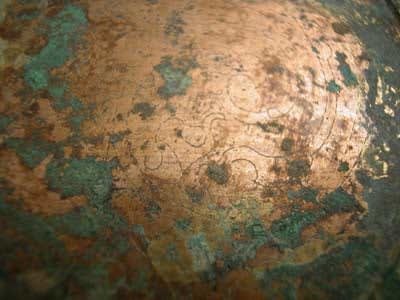Warring States Gilt Bronze Bowl, 475 BCE - 221 CE
Gilt Bronze
6
H.645
Further images
Whereas before, war was characterized as a civilized contest between aristocratic armies, during the Warring States Period (475-221 B.C.), war evolved into the chaotic conflict we know it as today....
Whereas before, war was characterized as a civilized contest between aristocratic armies, during the Warring States Period (475-221 B.C.), war evolved into the chaotic conflict we know it as today. Kings and princes were replaced on the battlefield by infantries lead by military generals. Peasants were recruited to serve on the front lines. Warfare intensified, especially in terms of the duration of campaigns. New arms and armor were invented, including the halberd and crossbow. Chariots rode alongside archers outfitted in iron helmets and body armor. Defensive walls were erected in order to repel invaders. However, despite the turmoil of the times, the arts continued to thrive. Bronze casting was revolutionized by the introduction of the lost-wax technique, while the alterations of kiln structures enabled new firing techniques that resulted in fully developed glazes.
This gorgeous bowl is the epitome of luxury. Even during the tumultuous, chaotic times of the Warring States, wealthy nobles still sought to surround themselves with beauty, both in this world and the next. In this era of ancient China, the afterlife was viewed as an extension (and perfection) of our earthly existence. This belief resulted in the creation of , literally translated as: “objects for the next world.” Elite members of the social hierarchy were interred with elaborate imitations of their earthly dwellings. Architectural models, guardians and warriors, attendants and musicians, livestock, furniture, and cooking utensils rendered in all media are commonly discovered in such tombs. These various replicas served a variety of functions. They partly symbolized the wealth and class of the deceased, as well they attested to the familial piety of the descendants who arranged and commissioned (often to the point of financial uncertainty) the works.
However, the do not simply reflect the earthly wealth of the deceased and his family, for they also serve a vital function in the afterlife. Human figures provided company and security while herd of livestock provided food and sustenance throughout eternity. Stoves and utensils were entombed to prepare feasts and celebrations as well as wine and grain storage vessels. The courtly entourage and ceremonial hardware would accompany the deceased into the afterlife. This gilt bronze bowl is a splendid example of . It is possible too that this bowl was treasured in life and not specifically created to be buried (as most of the terracotta sculptures and utensils were). The fact that this bowl may have been valued as much in life as in the afterlife makes it that much more splendid. Such a bowl would have been likely used as a wine tasting cup, a required object for any proper feast or ceremony. Elegantly decorated with incised geometric and curvilinear motifs, this bowl was surely the much-admired centerpiece of ancient ceremonial rituals both in this world and in the next.
This gorgeous bowl is the epitome of luxury. Even during the tumultuous, chaotic times of the Warring States, wealthy nobles still sought to surround themselves with beauty, both in this world and the next. In this era of ancient China, the afterlife was viewed as an extension (and perfection) of our earthly existence. This belief resulted in the creation of , literally translated as: “objects for the next world.” Elite members of the social hierarchy were interred with elaborate imitations of their earthly dwellings. Architectural models, guardians and warriors, attendants and musicians, livestock, furniture, and cooking utensils rendered in all media are commonly discovered in such tombs. These various replicas served a variety of functions. They partly symbolized the wealth and class of the deceased, as well they attested to the familial piety of the descendants who arranged and commissioned (often to the point of financial uncertainty) the works.
However, the do not simply reflect the earthly wealth of the deceased and his family, for they also serve a vital function in the afterlife. Human figures provided company and security while herd of livestock provided food and sustenance throughout eternity. Stoves and utensils were entombed to prepare feasts and celebrations as well as wine and grain storage vessels. The courtly entourage and ceremonial hardware would accompany the deceased into the afterlife. This gilt bronze bowl is a splendid example of . It is possible too that this bowl was treasured in life and not specifically created to be buried (as most of the terracotta sculptures and utensils were). The fact that this bowl may have been valued as much in life as in the afterlife makes it that much more splendid. Such a bowl would have been likely used as a wine tasting cup, a required object for any proper feast or ceremony. Elegantly decorated with incised geometric and curvilinear motifs, this bowl was surely the much-admired centerpiece of ancient ceremonial rituals both in this world and in the next.







